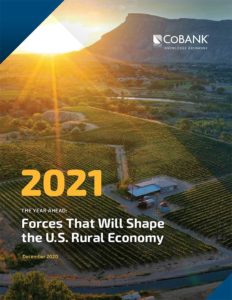Which Forces Will Shape the Rural Ag Economy in 2021?
 The speed of the U.S.’s rural economic recovery will largely hinge on the availability, dissemination, and reach of COVID-19 vaccines, pushing the expected burst of pent-up consumer demand into the latter half of 2021, according to a comprehensive year-ahead outlook report from CoBank’s Knowledge Exchange division.
The speed of the U.S.’s rural economic recovery will largely hinge on the availability, dissemination, and reach of COVID-19 vaccines, pushing the expected burst of pent-up consumer demand into the latter half of 2021, according to a comprehensive year-ahead outlook report from CoBank’s Knowledge Exchange division.
“The coming year will be a recovery year for most Americans and the businesses that make up the U.S. economy,” says Dan Kowalski, Vice President of CoBank’s Knowledge Exchange division. “The early part of the year should look very different than the latter, but in total, economic growth is estimated to be about 4%, following a retreat of roughly 4% in 2020.”
The CoBank 2021 outlook report examines key factors that will shape agriculture and market sectors that serve rural communities throughout the U.S.
Global Economy: Uneven Recovery Ahead
Against all hope that COVID would fade in 2020, it will continue to steer the global economy in 2021. Global economic recovery was very uneven in 2020, and given the current surge in virus cases, that is expected to remain the case in 2021. CoBank’s confidence in GDP forecasts has increased since mid-2020, but uncertainties related to the dissemination and uptake of vaccines mean timing the recovery is still exceedingly difficult. Of all major economies, China recovered the fastest from the pandemic and will finish 2020 in remarkably good economic shape, while Europe has suffered the most. Perhaps one of the longest lingering impacts from COVID will be the mountains of debt absorbed by most governments around the world.
U.S. Economy: COVID Is Still the Economy
A post-COVID bounce is coming to the U.S. in 2021, but it’s unlikely to happen soon. Much of the year’s economic trajectory will depend on fiscal policy decisions made over the next couple of months. Roughly 10 million Americans who lost their jobs early in the pandemic have yet to find work, and many of them are receiving some form of public support. If and how Congress chooses to fund further relief will impact the speed of the recovery. Throughout the first half of the coming year, many businesses will be trying to just keep the doors open. Optimism, however, should spur investment and capex decisions in the first half of the year. Opportunistic firms will attempt to time the comeback with new investments into the leisure and broader services sectors. Not all things will return to the way they were, though. Some industries may never fully recover.
Monetary Policy: Less Dramatic but No Less Critical
If there is an economic hero amidst the pandemic, it is most certainly the central banks. The Federal Reserve in particular stabilized the global financial system within weeks of the pandemic taking hold, and it continues to provide massive amounts of economic support. The role of central bank policy in 2021 should be less dramatic but no less important. With short term interest rates firmly at zero, the Federal Reserve will manage a few levers in the coming year, advocating for fiscal policy and keeping a close watch on longer-term rates and inflation, among other things.
U.S. Government: Sweeping Leadership Changes
As the 117th Congress begins, the political landscape is still somewhat uncertain. The Biden administration transition is proceeding apace. The House will remain Democratic with a smaller majority of no more than nine seats. In the Senate, control will be decided by a January 5 runoff election for both Georgia Senate seats. The narrow margin of power within Congress will moderate legislation. The Biden administration cabinet will be more diverse than President Trump’s, but is unlikely to shift to its leftward extreme, as indicated by the selection of former USDA Secretary Tom Vilsack for that role. The COVID response will be job one, followed closely by responding to the economic impact of the pandemic. The other priorities of the president-elect, including re-engaging with the rest of the world, investing in infrastructure, addressing social justice, climate change and trade, will all depend on getting the virus under control and getting the economy firing on all cylinders.
U.S. Farm Economy: A Strong 2020 Finish Boosts Potential
Higher commodity prices and low interest rates will be an important financial buffer to net farm income in 2021 with the federal government’s role in farm payments expected to greatly diminish. Federal government was the source of more than one-third of U.S. net farm income in 2020 with USDA providing extraordinary payments through a variety of programs. Crop prices have been bolstered by robust Chinese purchases and dry growing conditions in key growing regions of the world. Historically low interest rates will lower borrowing costs for farmers and ranchers. The value of farmland, which is an important source of equity for farmers and ranchers, is also expected to remain stable in 2021.
Specialty Crops: Preparing for More Shifts in Consumer Demand
The specialty crops sector will continue to adapt to historic shifts in logistics and supply chains in 2021 as the COVID-19 pandemic causes consumers to purchase more food at retail and less through foodservice. With thousands more restaurants expected to permanently close through the winter months as COVID-19 cases surge, specialty crop growers and the supply chains that deliver fruits, nuts, and vegetables will have to continue adapting to a consumer eating more at home. Some growers, packers, and processors have successfully managed to increase or reroute products into retail channels like grocery stores and home delivery of food boxes. However, steep financial losses from the loss of foodservice contracts will ultimately result in the rationalization of some processing assets and production acreage.
Rural Electricity: From Reactive to Adaptive
The common need to turn a corner, pivoting from being pandemic-reactive to market adaptive, opens the door to a more decisive response from U.S. power suppliers to changed market conditions. Amplifying the call for action are shifts in policy, costs of new technology, and consumer requirements — all of which conspire against a business-as-usual restrained pace to energy transition in 2021.
Rural Communications: Big Spending Not Likely, But Regulatory Change Is
With a new president and a likely split Congress, it’s likely that any COVID-related stimulus will focus on near-term economic needs versus investing in projects that take years to produce results. That leaves the Federal Communications Commission (FCC) as the remaining institution in Washington to enact policies that will help rural communication providers. In 2020 the FCC held its Citizens Broadband Radio Service (CBRS) spectrum auction that was much more rural friendly than any of its past auctions. And as a result, rural operators are now able to build carrier-grade fixed wireless networks at significantly reduced.
You can access the complete CoBank report here.








